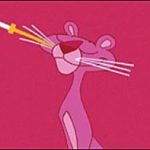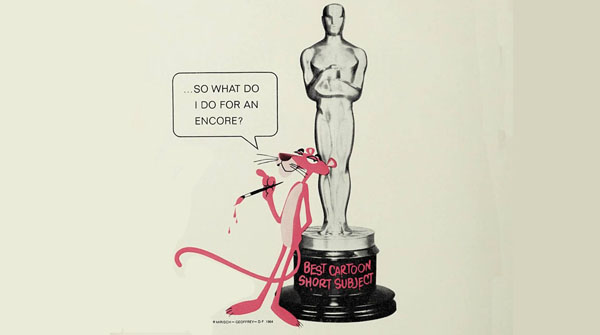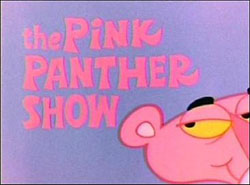



Animated opening credits were a popular trend in live-action films, acting almost like a cartoon short within the movie itself and as an entertaining way to draw audiences into the film that was to follow.
One of the most famous of these was part of director Blake Edwards classic 1963 comedy heist film, The Pink Panther. The film centered on the theft of a diamond, which looked as if a pink panther was leaping within it when held up to the light.
 This unique name inspired animated opening credits featuring the titular panther, mischievously interacting with the titles and staying one step ahead of an animated version of Inspector Clouseau (made famous in the films by the brilliant Peter Sellers) all set to one of the most famous music scores in movie history by Henry Mancini.
This unique name inspired animated opening credits featuring the titular panther, mischievously interacting with the titles and staying one step ahead of an animated version of Inspector Clouseau (made famous in the films by the brilliant Peter Sellers) all set to one of the most famous music scores in movie history by Henry Mancini.
The titles were directed by the legendary Friz Freleng, who spent a large part of his career at Warner Bros., where he created many of that Studio’s most famous animated stars. The titles had been produced by DePatie-Freleng Enterprises, which had been formed by Freleng and executive David H. DePatie.
The opening credits were such a hit with audiences that United Artists signed the Studio to begin producing short subjects featuring the Pink Panther. The first of these, The Pink Phink, won the 1964 Oscar.
 The character’s popularity eventually led him to Saturday morning television fifty-five years ago this month, when The Pink Panther Show debuted on September 6th, 1969, on NBC. The series would feature two Pink Panther shorts, and sandwiched in the middle would be a short subject starring an animated version of the Inspector. Actor Marvin Miller also narrated Pink Panther’s short “bumper” segments.
The character’s popularity eventually led him to Saturday morning television fifty-five years ago this month, when The Pink Panther Show debuted on September 6th, 1969, on NBC. The series would feature two Pink Panther shorts, and sandwiched in the middle would be a short subject starring an animated version of the Inspector. Actor Marvin Miller also narrated Pink Panther’s short “bumper” segments.
The Pink Panther shorts worked so well and connected with audiences because the character, who didn’t speak and expressed himself through comedic pantomime personality, was in the tradition of silent films and other cartoon stars like Felix the Cat and Tom and Jerry.
The conceits of the shorts were fairly simple but resulted in creative humor – in “Slink Pink,” the Pink Panther attempts to escape the cold by sneaking into a nice, warm house, only to find that it’s the home of a big game hunter and he must pose as one of his stuffed taxidermy conquests. The Panther continually outsmarts the hunter’s suspicious dog and stays in the house. “Pink Suds” finds the Pink Panther at the laundromat, tangling with the washers, dryers, and other patrons.
 In these and other shorts, the put-upon target of the Pink Panther’s mischief was a short man with a cartoonishly large nose and bristle mustache, known as “The Little Man.”
In these and other shorts, the put-upon target of the Pink Panther’s mischief was a short man with a cartoonishly large nose and bristle mustache, known as “The Little Man.”
Several talented animation veterans brought the Pink Panther to the screen, including writer John Dunn and directors Hawley Pratt, Gerry Chiniquy, and Sid Marcus.
Other animated segments would eventually join The Pink Panther Show as it evolved through its lengthy run on Saturday morning. These included The Aardvark and the Ant (both voiced by comedian John Byner, where the former talked like Jackie Mason and the latter, like Dean Martin), the self-explanatory Tijuana Toads (voiced by Larry D. Mann and Don Diamond) and Misterjaw (Arte Johnson) about a top-hat sporting great white shark, which sprang from the popularity of Jaws.
 From his debut series, the Pink Panther remained a fixture on Saturday mornings for many years, changing titles, such as The Think Pink Panther Show and The Pink Panther Laugh and a Half, Hour and a Half Show, and eventually shifting networks to ABC.
From his debut series, the Pink Panther remained a fixture on Saturday mornings for many years, changing titles, such as The Think Pink Panther Show and The Pink Panther Laugh and a Half, Hour and a Half Show, and eventually shifting networks to ABC.
The character would gain a family in the 1980s with Pink Panther and Sons and was given a voice provided by actor Matt Frewer in a 1990s incarnation.
But, throughout the series and character changes since his TV debut fifty-five years ago, The Pink Panther has remained the animated gem that audiences first fell in love with during those opening titles in 1963.